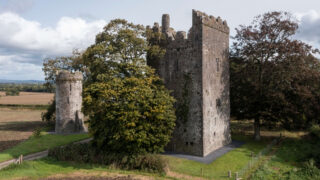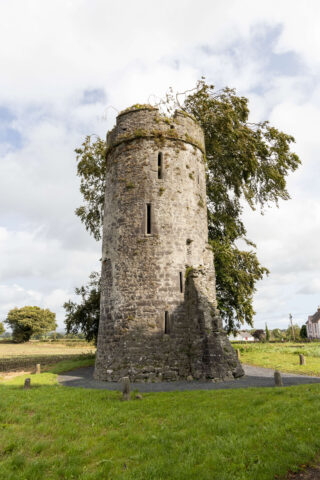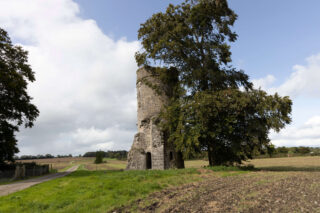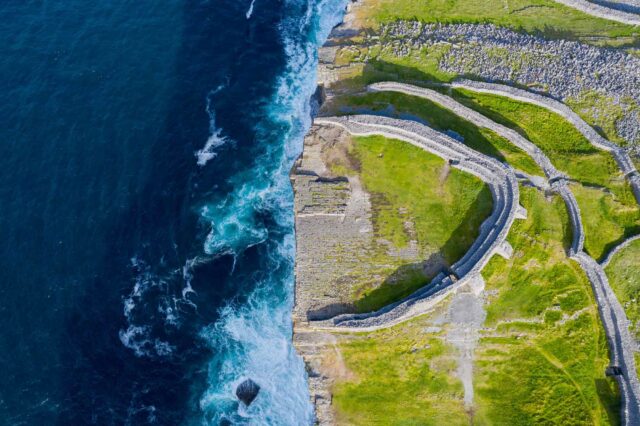Fógra
Burnchurch Castle and Turret
Built in the 15th or 16th century by the Fitzgerald family, known also by the surname of Barron and Baron, Burnchurch Castle is situated in the townland and the grounds of the former large estate of Farmley, 10.2 kilometres (6.4 miles) south west of the city of Kilkenny. It was continuously occupied until the early 19th century.
Burnchurch was originally named Cill Dalláin, meaning 'The Church of Dallán', which was founded in the 6th century by Saint Dallán (530 AD - 598 AD). Although the Irish name was later corrupted into different spellings, such as Kiltranyn, Kiltranen, Kyltranyn, Kiltranye and Kiltranyheyn, the version of Kiltrani seems to be the earliest recorded usage, in 1225 AD.
Records state that during the march of his Scot’s army through Kilkenny, King Robert the Bruce burned Kiltranyn in 1316, which, thereafter, was known as Burnchurch (in Gaelic 'Teampall Loiscthe' or The Incinerated Church', and whose Latin name was 'Ecclesia Cremata' and 'Ecclesia Combusta'). The earliest mention of the name Burnchurch dates from the beginning of the 15th century.
On the 12th February 1526, Peter the Red, Earl of Ormond, appointed Rowland FitzMaurice, Baron "de Ecclesia Cremata", his attorney for the placing of certain chaplains "in seisin", a term denoting the legal possession of a feudal fiefdom.
One of its later owners, Richard Fitzgerald, or Baron, joined in the Confederate Movement and, in 1653, under Cromwell’s rule, lost his estate to Colonel William Warden, including 244 acres of Burnchurch, and was transplanted to Connaught in 1654. The property later passed by marriage to the Flood family, of whom the Rt. Hon. Henry Flood (1732-1791) was a prominent member.
Although originally situated in the townland of Burnchurch, by the 1880s the owners of the Farmley estate had extended their property eastwards, and along with it the Farmley townland. They inserted into the landscape a long avenue from Burnchurch village through the parkland to the front door of the main residence. Thereafter, the castle and its turret stood at the entrance gate of this avenue.
As for the castle itself, it is six stories high and contains many chambers and passages, including a secret chamber which is reached by descending from the fourth floor. To the left of its north-facing doorway, stone stairs in straight flights ascend through the thickness of the walls. A circular chimney drew smoke up from the large fireplaces in the main living rooms on the the fourth and fifth floors. The fifth-floor was the main living space and has a vaulted ceiling. Its fireplace, with its massive stone mantle, is similar to that found in Clara Castle, east of Kilkenny city. Twin-light ogee-headed mullioned widows and rectangular single-light windows light the main rooms.
Internal staircases on three of its corners gave access to the crenelated split-level defensive wall-walks. On the north-facing and south-facing sides of the castle, the walls were extended upwards to form rectangular castle-wide turrets. Placed at roof level directly above the north-facing entrance doorway is a murder hole. Upwardly-tapering stone arrow slits, similar to those found at Tullaun Castle, in Lisquillibeen, Co. Tipperary, are strategically placed at all floor levels of the castle’s four walls.
Parts of the enclosing bawn wall of Burnchurch Castle were still standing in 1851 but now no longer survive. Its exact outline appears in the Ordnance Survey maps of the 1830s and it was connected to the 12.5 metre (41 feet) circular observation and defensive turret that stands directly north of the castle.
There is a Holy Well in the middle of Burnchurch townland named 'Tobar San Dallán' (St. Dallan's Well) which is dedicated to the saint.
The Rt. Hon. Henry Flood of Farmley, Irish patriot, statesman and orator, is buried in the adjoining graveyard.
Protect our Past - Click here to read about the importance of protecting our country’s unique heritage sites
This national monument is protected in accordance with the National Monuments Acts 1930 to 2014
Gailearaí
Suíomhanna cóngarach
Áiteanna le foireann
Prióireacht Cheanannais
Tabhair cuairt ar an suíomh eaglasta iata is mó in Éirinn
Timpeall 4.7 km ón
Caisleán Chill Chainnigh
An tseoid is luachmhaire i gcathair dhraíochtúil mheánaoiseach
Timpeall 8.9 km ón
Mainistir Sheireapúin
Ceann de na fothracha Cistéirseacha is breátha in Éirinn
Timpeall 11.9 km ón




